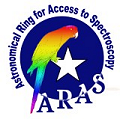ARAS Spectral Database
About ARAS initiative

Astronomical Ring for Amateur Spectroscopy (ARAS) is an informal group of volunteers who aim to promote cooperation between professional and amateur astronomers in the field of spectroscopy. To this end, ARAS has prepared the following roadmap:
- Identify centers of interest for spectroscopic observation which could lead to useful, effective and motivating cooperation between professional and amateur astronomers.
- Help develop the tools required to transform this cooperation into action (i.e. by publishing spectrograph building plans, organizing group purchasing to reduce costs, developing and validating observation protocols, managing a data base, identifying available resources in professional observatories (hardware, observation time), etc.
- Develop an awareness and education policy for amateur astronomers through training sessions, the organization of pro/am seminars, by publishing documents (web pages), managing a forum, etc.
- Encourage observers to use the spectrographs available in mission observatories and promote collaboration between experts, particularly variable star experts.
- Create a global observation network.
ARAS has developed in cooperation with professional teams an observing program of Be Stars relied on the BESS database which collects professional and amateurs spectra: http://basebe.obspm.fr/basebe/.
A monthly Letter provided by Valérie Desnoux summarize the observations and main events.
The ARAS website developed by Christian Buil provides a huge amount of information about technics and observations: http://astrosurf.com/aras/.
Last but not least, the ARAS forum allows a strong link between observers in the field of spectroscopy, from technics to observing programs with more than 15000 posts since 2011: http://www.spectro-aras.com/forum/index.php.
The forum is hosted by OVH with the financial support of Shelyak (https://www.shelyak.com/).
Eruptive Stars Section
Spectroscopic monitoring of eruptive stars (e.g. symbiotic binaries, classical novae) by amateurs around the world, in both the northern and southern hemispheres, is a fundamental activity of the ARAS initiative. The group of volunteers demonstrates what can be accomplished with a network of independent, very small telescopes (from 20 to 60 cm), furnished with spectrographs of different resolutions, from 500 to 15000, and covering the range from 3600 to 9000 Å. The observing program concentrates on bright symbiotic stars (67, to date) and novae (41, to date). The main features of the ARAS activity are a rapid response to alerts, long-term monitoring, and high cadence. A part of the program involves collaborations based on requests from professional teams (e.g. CH Cyg, AG Dra, R Aqr, SU Lyn, T CrB) for long-term monitoring or specific events.
The purpose of ARAS in fostering the participation of amateur astronomers in scientific projects in the field of spectroscopy is to implement and coordinate observing campaigns and monitoring. ARAS also responds to requests from astronomy research scientists, laboratories, or international consortiums. ARAS attempts to consolidate the acquired data into a web database and ensure that the quality of its data is compatible with scientific processing methods.
The observations are summarized in a quarterly news letter which is indexed in NASA/ADS. The previous issues can be downloaded from: http://www.astrosurf.com/aras/novae/InformationLetter/InformationLetter.html.
At the date, about 100 publications are partially or mainly based on ARAS Eruptive Stars spectra.